#zoning
Text
Tom the Dancing Bug: Can Lucky Ducky find a home?
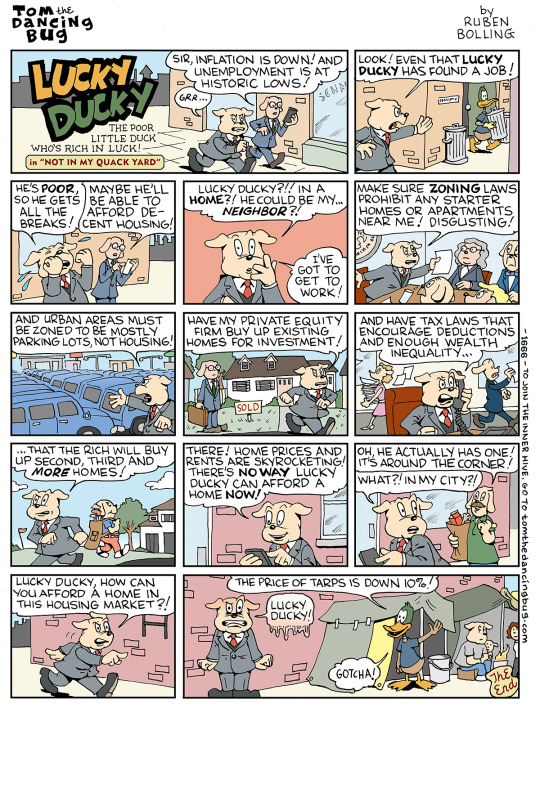
https://boingboing.net/2023/12/20/tom-the-dancing-bug-can-lucky-ducky-find-a-home.html
145 notes
·
View notes
Text
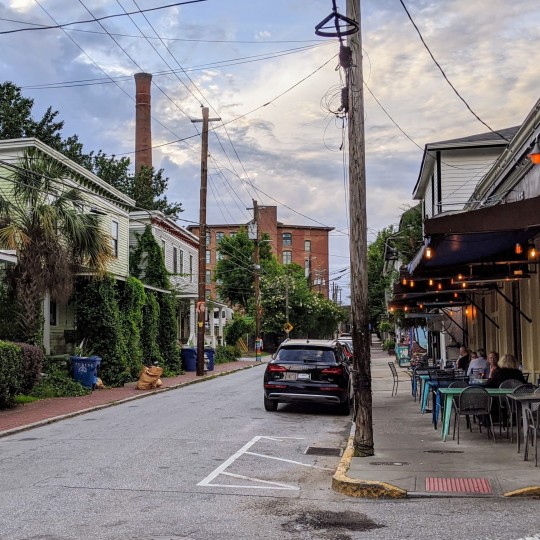


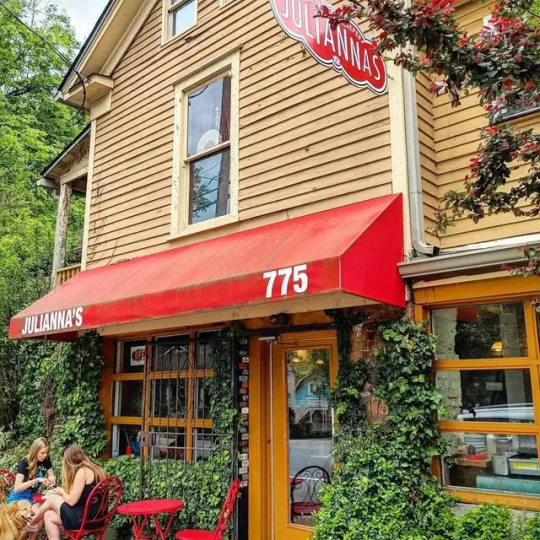
The most loveable streets in Atlanta have detached houses and multifamily houses and stores mixed together in a pedestrian-oriented format.
Yet there are zoning districts that disallow this mix, excluding everything but detached homes -- they treat triplexes and small stores like toxic waste that shouldn't be allowed nearby.
It's weird to make it illegal to build the most beautiful kind of urban fabric that cities can create. We should stop this practice and let the city be a city.
71 notes
·
View notes
Note
Re zoning regulation reform: could you go into detail as what that would look like in terms of wiping the slate clean. I feel like it would be better to go the houston route and just be zoning free
You do not want to go the Houston route.
youtube
Houston may claim to be "zoning-free" - and to be fair, it doesn't have some of the more common regulations on land use, or density, or height restrictions (more on this in a minute) - but the reality is far more complicated and the status quo is not one that's friendly to the interests of working-class and poor residents, or to the possibility of sustainable urbanism.
The answer to NIMBYism isn't to abolish all regulations and let the free market rip, it's to surgically target zoning, planning, and litigation that is used against affordable housing, public/social housing, mass transit, clean energy, and walkable neighborhoods, and to replace it with new forms of regulation that encourage these forms of development.
So let's take take these categories in order.
Zoning
As I tell my Urban Studies students, zoning is both one of the most subtle and yet comprehensive ways in which the state shapes the urban environment - but historically it has been used almost exclusively in the interests of racism and classism. Reforming zoning requires going over the code with a fine-toothed comb to single out all the many ways in which zoning is used to make affordable housing impossible:
The most important one to tackle first is density zoning and building heights limitations. The former directly limits how many buildings you can have per unit of land (usually per acre), while the latter limits how big the buildings can be (expressed either as the number of stories or the number of feet, or as both). Closely associated with these zoning regulations are minimum lot size regulations (which regulate how much land each individual parcel of real estate has to cover, and thus how many how many housing units can be built in a given area), and lot coverage, setbacks, and minimum yard requirements (which limit how much square footage of a lot can be built on, and what kinds of structures you can build).
the other big one is use zoning. To begin with, we need to phase out "single use" zoning that designates certain areas as exclusively residential or commercial or industrial (a major factor that drives car-centric development, makes walkable neighborhoods impossible, and discourages the "insula" style apartment building that has been the core of urbanism since Ancient Rome) in favor of "mixed use" zoning that allows for neighborhoods that combine residential and commercial uses. Equally importantly, we need to eliminate single-family zoning and adopt zoning rules that allow for a mix of different kinds of housing (ADUs, duplexes and triplexes, rowhouses/terraced houses, apartment buildings).
finally, the most insidious zoning requirements are seemingly incidental regulations. For example, mandatory parking minimums not only prioitize car-dependent versus transit-oriented development but also eat up huge amounts of space per lot. The most nakedly classist is "unrelated persons" zoning, which is used to prevent poorer people from subdividing houses into apartments, which zaps young people who are looking to be roommates and older people looking to finance their retirements by running boarding houses or taking in lodgers, as well as landlords looking to convert houses from owner-occupied to rental properties.
So I would argue that the goal of reform should be not to eliminate zoning, but rather to establish model zoning codes that have been stripped of the historical legacies of racism and classism.
Planning
Similar to how zoning shouldn't be abolished but reformed, the correct approach to planning isn't to abolish planning departments wholesale, but to streamline the planning process - because the problem is that right now the planning process is too slow, which raises the costs of all kinds of development (we're focusing on housing right now, but the same holds true for clean energy projects), and it allows NIMBY groups to abuse the public hearings and environmental review process to block projects that are good for the environment and working-class and poor people but bad for affluent homeowners.
As those Ezra Klein interviews indicate, this is beginning to change due to a combination of reforms at both the state and federal level to speed up the CEQA and EPA environmental review process in a number of ways. For example, one change that's being made is to require planning agencies and environmental agencies to report on the environmental impact of not doing a project as well, to shift the discussion away from petty complaints about noise and traffic and "neighborhood character" (i.e, coded racism and classism) and towards real discussions of social and environmental justice.
At the same time, more is needed - especially to reform the public hearing process. While originally intended by Jane Jacobs and other activists in the 1970s as a democratic reform that would give local communities a voice in the planning process, "participatory planning" has become a way for special interests to exercise an unaccountable veto power over development. Because younger, poorer and more working class, and communities of color often don't have time to attend public hearing sessions during the workday, these meetings become dominated by older, whiter, and richer residents who claim to speak for the whole of the community.
Moreover, because community boards are appointed rather than elected and public hearings operate on a first-come-first-serve basis, an unrepresentative minority can create a false impression of community opposition by "stacking the mike" and dialing up their level of militancy and aggression in the face of elected officials and civil servants who want to avoid controversy. (It's a classic case of diffuse versus concentrated interests, something that I spend a lot of classroom time making sure that my students learn.)
Again, the point shouldn't be to eliminate public hearings and other forms of participatory planning, but to reform them so that they're more representative (shifting public hearings to weekends and allowing people to comment via Zoom and other online forums, conducting surveys of community opinion, using a progressive stack and requiring equal time between pro and anti speakers, etc.) and to streamline the review process for model projects in categories like affordable housing, clean energy, mass transit, etc.
Litigation
Alongside the main planning process, there is also a need to reform the litigation process around development. In addition to traditional tort lawsuits from property owners claiming damage to their property from development, a lot of planning and environemntal legislation allows for private groups to sue over a host of issues - whether the agency followed the correct procedures, whether it took into account concerns about this impact or that impact, and so forth.
As we saw with the case of Berkeley NIMBYs who used CEQA to block student housing projects over environmental impacts around "noise," this process can be used to either block projects outright, or even if the NIMBYs eventually lose in court, to draw out the process until projects fall apart due to lack of funding or the proponents simply lose their patience and give up.
This is why we're starting to see significant reforms to both state and federal legislation to streamline the litigation process. The categorical exemptions from review that I discussed above also have implications for litigation - you can't sue over reviews that didn't happen - but there are also efforts to speed up the litigation process through reducing what counts as "administrative record" or by putting a nine-month cap on court proceedings.
Again, this is an area where you have to be very surgical in your changes. Especially when the politics of the issue divide environmental groups and create odd coalitions between labor, business, climate change activists, and anti-regulation conservatives, you have to be careful that the changes you are making benefit affordable housing, clean energy, mass transit and the like, not oil pipelines and suburban sprawl.
#public policy#housing#zoning#policy history#urban planning#public housing#social housing#yimbys#yimbyism#affordable housing#urban studies#urbanism#houston#nimbyism#nimbys#environment#climate change#clean energy
93 notes
·
View notes
Photo
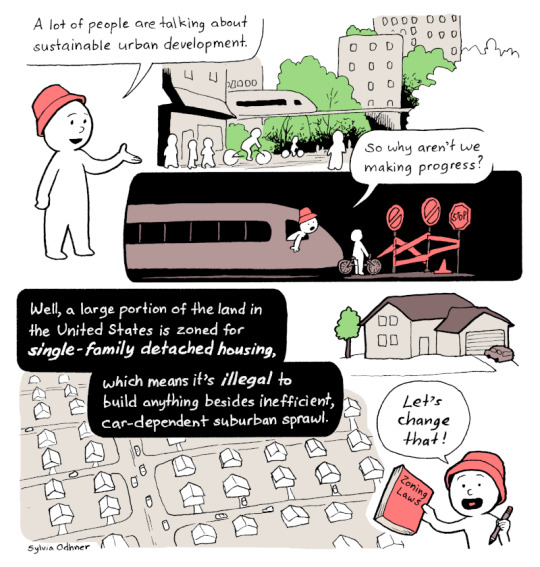
Why Can’t We Build Better Towns?
A lot of people are talking about sustainable urban development. So why aren’t we making progress? Well, a large portion of the land in the United States is zoned for single-family detached housing, which means it’s illegal to build anything besides inefficient, car-dependent suburban sprawl. Let’s change that!
Inspired by this awesome Climate Town video: The Suburbs are Bleeding America Dry. I recommend watching it if you want to learn more about this subject.
And here’s an article that my friend Tim Shores found, that gets into the problems with single-family zoning: It’s Time to End Single Family Zoning.
604 notes
·
View notes
Photo

The owners of this property wanted a guest house in the back, but the town only allowed 320 sq. ft., so architect/general contractor Nicole designed this 550 sq. ft. home, called The Hive, to make a small footprint on the ground, but see how it flairs out for more living space? Very clever.
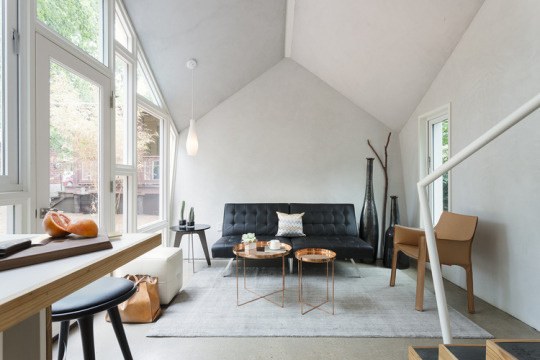
It has a nice living room with a wall of windows to let in lots of light.
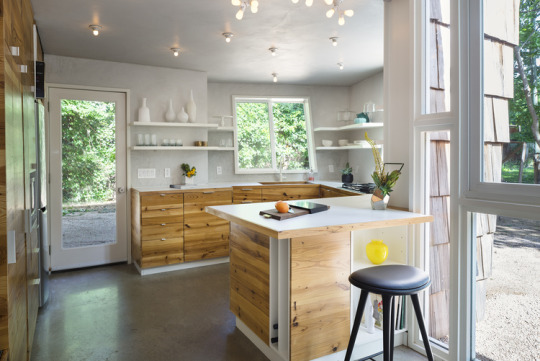
She gave it a nice, big kitchen with access to a back patio.

There’s a whole wall of storage, too.

Stairs lead up to a loft.

She built a desk into the landing.



Bedroom and closet are in the upper part of the house that bows out.


There’s even room for a nice size shower in here.

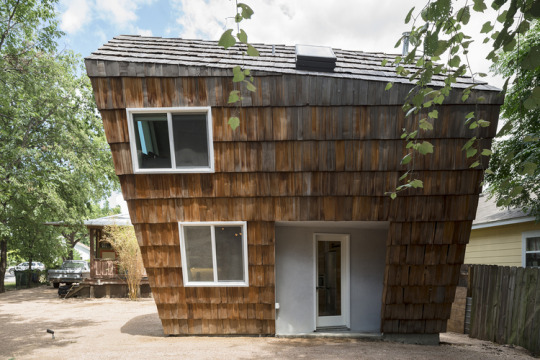
And, that is how you get a 500 sq. ft. home to fit on 320 sq. ft. of allotted space.
https://nicoleblair.com/cedar-shake-apartment/qwe75wyvgb7sdttfua55bt8b80pqua
243 notes
·
View notes
Photo

Hugh Ferris' 1922 zoning drawings showing the "Evolution of the Set-back Building." The 1916 zoning resolution required setbacks and restricted skyscrapers to a percentage of the lot size opposed to a specific height. Previously skyscrapers could rise straight up from the street with no height limits. The drawings were intended to help architects understand the rules of the zoning resolution and provided a model for the shaping a building that would use the maximum mass permitted by the zoning law. Ferris' drawings were widely published, including an article in the New York Times. He helped to inspire architects develop the new modern tower that would become the standard for 1930s setback, wedding cake, Art-Deco New York skyscrapers. This year marks the centennial of New York City's 1916 zoning resolution. #zoning #cityplanning #1916zoningresolution #setbackskyscraper #skyscraper #hughferris #nyczoning #cityplanning #modernism #artdeco #skyscraper #architecture (at Tribeca, New York City) https://www.instagram.com/p/Cqa-FXzOPRx/?igshid=NGJjMDIxMWI=
#zoning#cityplanning#1916zoningresolution#setbackskyscraper#skyscraper#hughferris#nyczoning#modernism#artdeco#architecture
42 notes
·
View notes
Text

Wonderful Things That May or May Not Be Wonderful!!!
Charge moves are a class of fighting game special attack where you hold one direction (usually down or backward) for a brief window of time before pressing the opposite direction along with a button in order to preform it. I I love these things as a lot of time I feel they have grant a supreme level of game feel. They convey the idea that you are "charging up", waiting for the right moment to strike, and unleashing all that stored power. A perfect example (though not the most archetypical) is Axl Low's Rensen Geki or Sickle Flash. Hold back or down back on the D-Pad, wait a couple seconds, press forward and slash, and watch as the time traveling brit's chain sickle glows bright and rips up everything in its path. BUT WAIT, THERE'S MORE! If you press up during the attack, Axl performs a follow-up where he flicks the sickle upward creating an enormous half-moon arc that catches anyone who tried to jump over the initial attack. BUT WAIT, THERE IS EVEN MORE! You can also press down to perform another follow up where you spin the chain like a tornado great for knockdowns and damage in the corner. Sure, you may only be doing a loose approximation of these actions on a hunk of plastic and computer chips, but in the moment when the world melts away, you feel as if you are performing the technique and it feels so wonderful to do so. Plus, it's just a really useful tool in Axl's move set.
#wonderful#axl low#guilty gear#the missing link#xx#xrd#strive#charge motions#fighting games#rensen geki#sickle flash#video game techniques#game feel#immersion#chain sickle#kusarigama#zoning
30 notes
·
View notes
Text

Hooray for small stores on the sidewalk, next to homes! Inman Park. Also, hooray for pretty brickwork.
Let's make sure that neighborhoods are *zoned* for corner stores. Making this kind of thing illegal, as it currently is in many places (even in the city) was a mistake.
Also, if you're interested in knowing why we made corner stores illegal, check out "Atlanta's War on Density," an excellent 2016 article about the history of our urban-design decisions.
Basically, 1940s-50s planners remade our urban spaces to accommodate heavy car flow (a decision clearly informed by class bias and racism, privileging people who could afford cars and suburban homes).
They used zoning laws to confine retail to parking-heavy strips on large arterial roads. In the process, they prevented us from having walkable spaces. Undoing that mistake is difficult, but necessary.
28 notes
·
View notes
Photo

Spokane, Washington's zoning reform
On Monday night, Spokane City Council adopted a package of interim zoning rules which establish the city as a nationwide leader in re-legalizing housing. After years of debate, task forces, Council hearings, and focus groups, it is now legal to build a duplex, a triplex, or a fourplex anywhere you can build a single-family home in the city.
The rules actually go further than the package briefed in The Urbanist earlier in the month, after amendments during the legislative process. When everything shook out, the final package:
Allows duplexes, triplexes, and fourplexes anywhere you can build a single-family home;
Removes unit limits on townhomes and rowhomes;
Reduces the required lot width to 36 feet in single-family (RSF) zones;
Reduces the minimum lot size for attached homes to 1,280 square feet;
Decreases and in some cases eliminates parking requirements near transit, and increases bike parking requirements to compensate;
Allows developers to round up in their density calculations (for example, if calculations yield 5.2 units allowed, you can now build six instead of five)
Applies new design standards similar to the city’s standard design requirements to all of these new unit types.
Full article >>
119 notes
·
View notes
Text
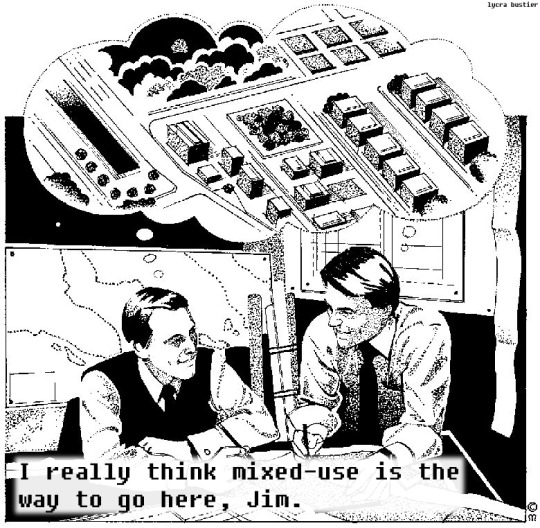
It really is -- Jim is just used to silo zoning for commercial use only.
#business#businesscore#nostalgia#office space#retro#business memes#vaporwave#1980s#80s aesthetic#mixed use#urban planning#zoning#clip art#clipart#memes
9 notes
·
View notes
Text
What is life exactly? do you ever ask yourself this? are we barely existing or are we surviving or are we just obliged to work about the hackneyed way of society?
Purposes of our lives are really questionable but one thing we can do is to take ourselves out of these isochronal lifestyle and sometimes just appreciate our presence around the world. We must not know our purposes here but we are chosen to be a part of a world of living . We are so tangled up right from the birth till teenage to study our asses off and then suddenly the horrible transition into adulthood which brings about tons of responsibilities and till we figure out and bring our life together its already time to leave .
Life has a whole lot to offer if you see around yourself and observe this beautiful creation of life. Everything has something to say to you. Look at the sunrise, its telling you how you could purify the dark void inside you and start afresh every morning with new rays of living will. The birds chirping showing us how we are meant to talk ourselves out and not worry about being too loud and apologize for the "bad mannerism" ,how our thoughts and feelings are supposed to fly out there and not meant to be captivated in the cages of illiberality . A bright beautiful flower which has bloomed even though it'll die in a short span, It is still standing out there cheerful and bright for the time its alive. The nights ,which are not so scary as they are thought to be , rather they bring a breeze of calmness and peace with it ,a time just to rest our hustling mind and heart and slow down the pace of life for a bit ; that's what night tells us. When you look at all this with an offbeat perspective you sure would find meaning in everything .
Our souls are fragile and overworking ourselves is quiet normalised rather its a necessity nowadays . But hey nothing is more powerful than a calm and composed mind and heart. SLOW DOWN,REST FOR A BIT,SMILE,DRINK SOME COFFEE WHILST LOOKIN AT A PRETTY SUNSET QUIETY, TRUST ME YOU NEED IT MORE THAN YOU THINK YOU DO.
5 notes
·
View notes
Text
Car-dependent sprawl is not a harmless option
Pedestrian-hostile suburbs aren’t balanced out by the presence of walkable urbanism elsewhere; they’re a problem that should be fixed.
By Darin Givens, 11/27/2022
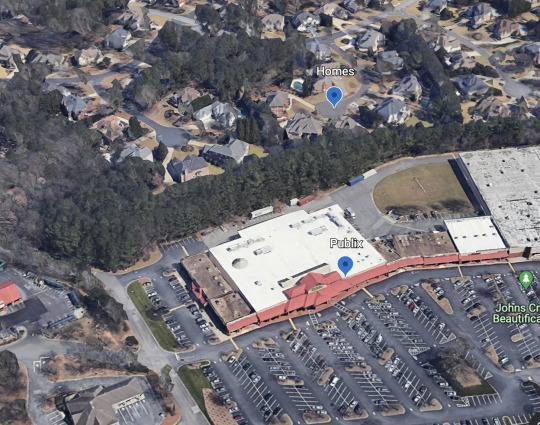
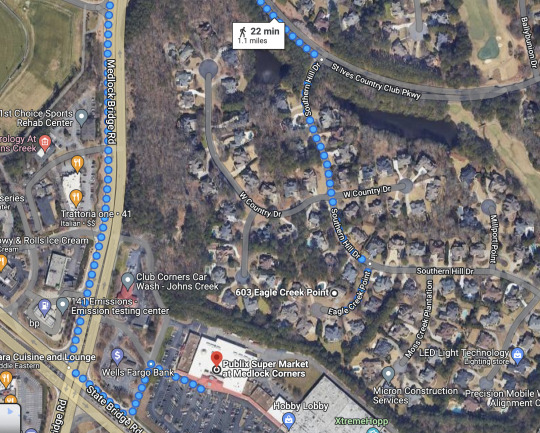
In Johns Creek, GA you can live a stone's throw from a grocery store that would require a whopping 1.1 mile trek if you wanted to walk to it instead of driving. This is the restrictive zoning that some people want, in order to "protect" single family homes from the scourge of walkable mixed-use urbanism.
Yes, this is the suburbs. But I don’t accept the argument that it’s OK to allow this for the people who want it as an option, versus walkable urban design. Certainly not at the incredible scale that we’ve seen in the past few decades worth of sprawl in the Atlanta metro area and elsewhere.
Buildable land is a precious resource in the Atlanta region. We aren't making more of it. In fact, to preserve unbuilt ecosystems, we need to stop sprawling into the dwindling forests of the Georgia Piedmont.
To improve health outcomes, we need to create less pollution and boost the safety of active transportation; sprawl is correlated with increased energy use and pollution. To improve equitable outcomes, we need neighborhoods near stores/jobs to be more walkable and more serviceable by transit. To improve services for the public, we need our land-use to capture as much value as possible (sprawl does the opposite).
Here’s the scene you would encounter on foot if you tried to get to the grocery store from the homes above. It’s an inhumane environment for pedestrians that demands access to a personal vehicle for navigating it, and for getting to daily necessities and jobs. Saying “if some people want inhumane spaces, we should support that desire with restrictive zoning laws” is ridiculous.

Car-centric sprawl is not a neutral, harmless “option” for living. It’s a thing that hinders progress on our health/climate/environmental goals. Local governments should not be providing it in mass quantities through restrictive zoning laws.
Many political conservatives complain about “nanny state” laws, but zoning laws which demand car-centric places while outlawing anything else are about as “nanny” as it gets. The government is enforcing automobile dependency through public laws — and the ‘public’ nature of it makes us all complicit in the harmful outcomes.
#suburban sprawl#sprawl#atlanta#urban sprawl#urban design#urbanism#urban planning#zoning#Car-dependency
144 notes
·
View notes
Text
Exploring the Innovative Sounds of Mary Lou Williams' "Zoning"
Introduction:
Mary Lou Williams, a pioneering figure in jazz history, released the album “Zoning” in October 1974. This groundbreaking work showcases Williams’ remarkable talent as a pianist, composer, and arranger, and it stands as a testament to her enduring influence on the jazz genre. Let’s delve into the world of “Zoning,” exploring its tracks, the critical reception it received, and the…
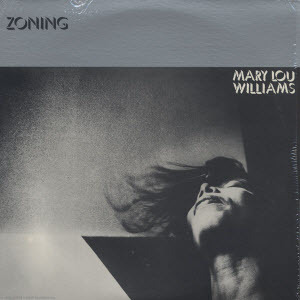
View On WordPress
2 notes
·
View notes
Text
Reason doesn't often flatter my biases this blatantly, but, goodness, I am flattered. Blaming the Great Recession on zoning!
The conventional view of the Great Recession is that excess demand for housing—caused by some combination of loose monetary policy, government-subsidized credit, and unscrupulous lenders—inflated a bubble that inevitably had to pop. Leftists, liberals, libertarians, and conservatives can all find something to agree with in this theory.
But it's wrong, according to Kevin Erdmann, a senior affiliated scholar at George Mason University's Mercatus Center. Erdmann has advanced a heterodox theory that this century's most serious economic contraction before the pandemic can be traced back to zoning laws in the most in-demand cities.
In a 2020 paper on the origins of the recession, Erdmann and economist Scott Sumner argue that monetary policy was not exceptionally loose in the lead-up to the financial crisis and that new residential investment was not high by historic standards. Most of the toxic assets and bad mortgages originated after housing prices had already started to decline.
Erdmann and Sumner also point out that prices were increasing fastest in coastal "closed access" cities like New York and San Francisco, where the economy was booming but restrictive zoning regulations prevented much new housing from being built. The result was an out-migration of lower-income people to "contagion cities" in Nevada, Florida, Arizona, and other places where home building was less regulated. Erdmann and Sumner lay the housing crisis directly at the feet of NIMBYs—"not in my backyard" activists who opposed the construction of new housing.
"The NIMBY phenomenon that led to housing scarcity in closed-access cities induced households to migrate from large multi-unit buildings in dense coastal cities to single-family homes in cheaper cities," write Erdmann and Sumner. "The primary source of demand was households looking to economize on housing consumption by moving out of the expensive coastal cities."
Think of Mark and Patricia McCloskey as a class of activist. The McCloskeys of San Francisco, Los Angeles, and New York City tried to protect their views, their property values, and their relatively low-traffic streets with zoning laws that banned apartments across whole swaths of the city. Lack of supply met huge demand, hiking prices in the process. Middle-class people were effectively priced out of urban apartments because those apartments were simply never built.
So instead of living in Los Angeles and New York City, middle- and lower-income people moved to Las Vegas and Phoenix. That influx of demand saw prices spike and builders respond by throwing up lots of new homes. The glut of new homes in inexpensive Sun Belt cities wasn't just the result of an overinflated financial system. It was a response to real demand from cost-burdened coastal emigrants.
All this had massive macroeconomic consequences. Erdmann and Sumner argue the Great Recession was ultimately caused by federal officials misinterpreting rising home prices as a bubble rather than the result of a real shortage. So they tightened monetary and lending policy, and that tipped a rational building boom into an artificially induced recession.
It's an out-of-the-box theory that deemphasizes or disputes many common libertarian diagnoses of the Great Recession that center on an overly profligate Federal Reserve or on reckless financial institutions banking on an inevitable federal bailout. But it does explain how the country was able to go from a supposed glut of housing oversupply to a shortage of somewhere between 4 million and 20 million homes. The glut was overinterpreted—and the shortage never went away.
When economic growth did come back in the 2010s, in the form of a "return to the city" movement, zoning restrictions that were already tight became positively strangling.
And:
If you take seriously the idea that politics is primarily downstream of material factors, you might blame zoning for a lot of the sheer craziness of American politics in the last decade too.
13 notes
·
View notes
Text
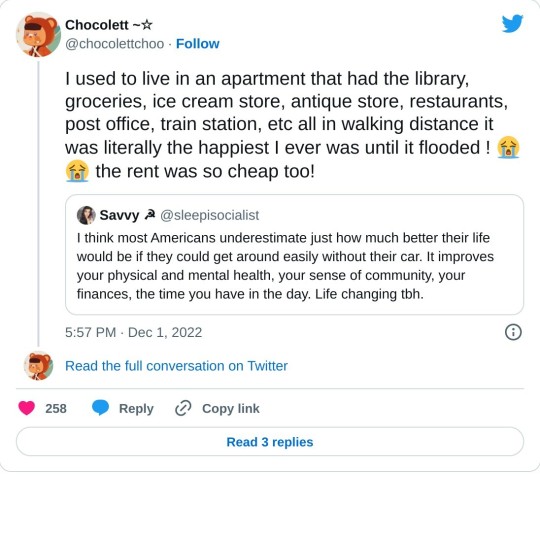
Every time i hear about walkable cities/neighborhoods, i remember this vlogbrothers vid:
youtube
Also, watch the YouTube channels "City Beautiful" and "Not Just Bikes".
#design#city planning#urban planning#urban design#walkability#cities#happiness#studies#research#daily commute#vlogbrothers#urban density#city density#zoning#Youtube
23 notes
·
View notes
Text
This is a picture of legislators opposing NY Governor Hocul's proposal to build more multiple-family housing in the state. The NYC region is egregious in its Jim Crow-era zoning laws to keep Jews, Asians, Blacks and other minorities out. This fact makes the picture above even more tone-deaf -- it's entirely old white men. Were there no PoC or women available? It probably never occurred to them it would be seen as a problem.
And that's a problem.
12 notes
·
View notes